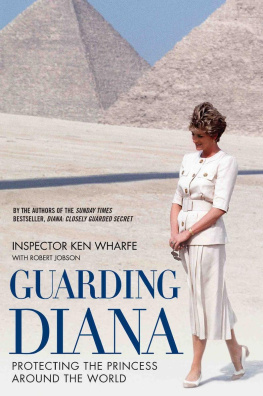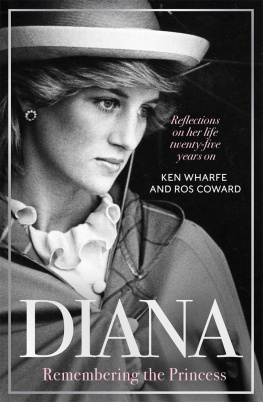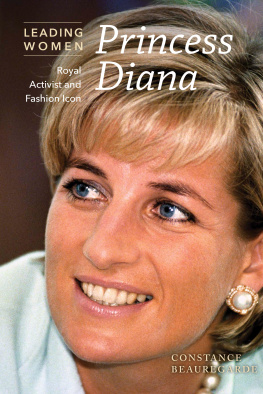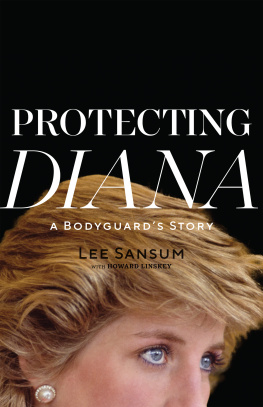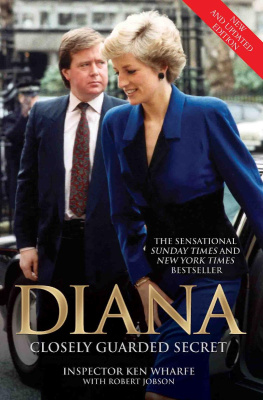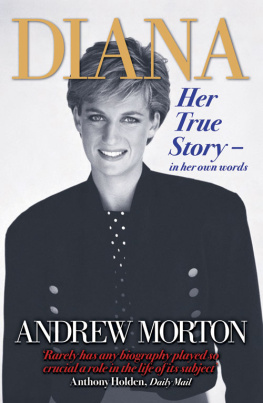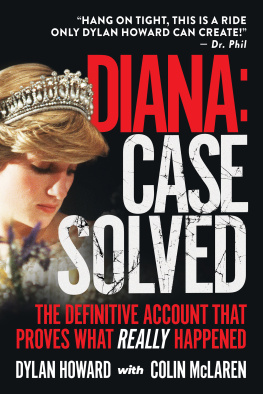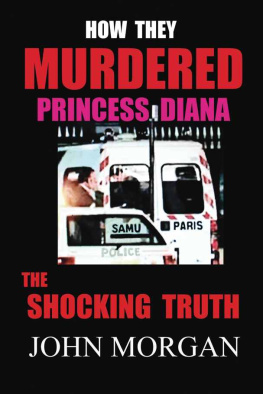I dont envy you, Ken, looking after my two sons, they can be a bloody nuisance. This was the first thing Diana, Princess of Wales, said to me a typical icebreaker. She had a natural nobility and charm that immediately put you at your ease and there were certainly no airs and graces about her. It was November of 1986 at Sandringham House, Her Majesty Queen Elizabeth IIs much-loved country retreat in the county of Norfolk, the private home of four generations of British monarchs. The Princess was staying there for a shooting weekend hosted by her then husband, His Royal Highness the Prince of Wales.
It was a courtesy call as I had already been appointed to the job. After all, she was not about to be my boss that would still be the Commissioner of the Metropolitan Police Force, back then Sir Kenneth Newman. Whatever the outcome of our meeting, my appointment as a royalty protection officer was made by Scotland Yard, not by the Queen or the Royal Family. Our first meeting followed a series of training modules following my selection as an officer in the department initially encouraged by the Queens policeman, Superintendent Jim Beaton, when he was my supervising officer at Kensington Police Station. My position was to be the personal protection officer (PPO) to Dianas young sons, Prince William and Prince Harry. (At this time I was appointed only to the young Princes only six months later did I transfer to Diana.) Our meeting was my formal introduction to a member of the Royal Family and I knew it would certainly help our working relationship if we had chemistry or at least a rapport between us, so I was feeling a little apprehensive.
From that moment on there was never a dull day working alongside the Princess, her two sons and the Royal Family. I was in charge of her security, at home and abroad, during one of the most traumatic periods of her life until the end of 1993. Diana was not always easy, but to be fair, who is? Most of the time, however, she was a joy to work with engaging, funny and someone who possessed a wicked sense of humour. It was my job as personal protection officer with Scotland Yards elite SO14 Department (Specialist Operations) to look after her as she went about her daily life. I was effectively her security shadow, her eyes and ears, at her side to protect her, should anyone for whatever reason try to do her harm.
Royalty Protection was a special department of the Metropolitan Police Force that I would serve for a total of sixteen years, most of them in charge of the team of elite officers who watched over Diana and her two sons. The role heading up her security detail meant I had to deal with her more sensitive private engagements and public appearances, her official foreign trips and her private holidays. It was not only my job to keep her safe, but to facilitate her daily activities both public and private in what was to be an all-too-short but extraordinary life. We travelled the world together and over time I became one of her most trusted confidants. The nature of my job meant I was party to detailed information others in her team even her most senior courtiers and domestic servants did not have.
In 2002, five years after Dianas death, I penned a memoir about my time serving as the Princesss PPO, the international bestseller Diana: Closely Guarded Secret. It is fair to say the book created a global media sensation. The British Establishment, including some sections of the UK press egged on by key figures in the old order, vilified me for what it claimed was a breach of trust. It didnt seem to bother them that royals, prime ministers, ambassadors and even former commissioners of the Metropolitan Police Force have all published their books. Even the former Director General of MI5, Dame Stella Rimington, published her autobiography, Open Secret, a month after my tome hit the shelves. The reality was that the cronies surrounding the Royal Family didnt like me telling the truth because it didnt marry with their preferred version of history and what they wanted the public to believe. But I took the criticism on the chin because I knew what I had published was the truth and portrayed the Princess as she was and in a positive light, true to life. My account was not a sugar-coated portrait either, it was an honest portrayal.
At that time Palace spin doctors were busy rewriting their version of the Charles and Diana story in the aftermath of her life, with the Princess as the deranged villain of the piece and the Prince of Wales the blood Royal, after all as the wronged party. It was all part of a carefully crafted plan to ensure his long-term mistress, Camilla Parker Bowles, would be accepted by the public as his wife and later as Queen Consort. In the press, at the time, Diana was denigrated, dismissed as mad, bad or both. I took the flak as I felt I was right to put the record straight for the sake of historical accuracy, but more importantly for the memory of the woman I knew to be a profoundly good, honest and decent human being. She wasnt perfect. However, she did her best to be a good wife and mother and to serve the Queen and the institution she married into.
Ultimately, my original memoir, in the opinion of respected historians and royal commentators, helped change the view of Diana, Princess of Wales. Leading historian Dr David Starkey backed the book, saying, This is history, since Ken Wharfe was there. Almost overnight it became a New York Times and Sunday Times runaway bestseller and has had four editions, and was often quoted as source material in books that followed. It stood the test of time because it was true and in so doing silenced the detractors.
This book, however, is different. It focuses on the exciting, colourful foreign visits Diana and I enjoyed when working together. In Diana: Closely Guarded Secret I have chronicled the circumstances of the Princesss untimely death in detail. For the record, in brief, it is my professional opinion, based on studying the subject in detail with a policemans eye and with my inside knowledge of the woman, that Diana was not murdered. I believe all the evidence points to the fact that she died in a tragic accident it is as plain and simple as that.
It seems wrong to me that after two exhaustive police investigations and a multi-million pound taxpayer-funded inquest that conspiracy theories still abound. So-called revelations that the SAS or rogue spooks were involved in the Princesss death will be categorically dismissed over time. To me it seems ridiculous that these theories are still given credence. Too many conspiracy theories have hijacked Dianas life achievements, and some of the claims have been downright tasteless, too. On Twitter I was even bizarrely accused of being part of some cover-up conspiracy for voicing this view. No, if there were a shred of evidence to show that Diana was murdered, then, like anyone, particularly a former policeman who served to protect her, I would absolutely want to expose it. But there is no evidence at all that she was. Her sons, whose views are surely the most important and telling, have said that they accept the findings of the inquest held in London in 2008. It is time we all did the same, or at least adhered to their wishes. Dianas death was due to the driver Henri Pauls grossly negligent driving under the influence of alcohol (he was not rolling drunk, but he had been drinking and was over the legal blood/alcohol limit), and the chasing foreign photographers who inflamed the situation. That is the truth.
So much has been written about the death of the Princess, twenty years ago in 2017, that the many achievements of her life are sometimes forgotten. So much has changed, too, in the Royal landscape. Her oldest son, HRH Prince William, Duke of Cambridge, has married his university sweetheart, Kate Middleton, and has a young family of his own. Sadly, Diana never lived to see Prince George and Princess Charlotte at play. Prince Harry has also made great strides in continuing the legacy of his late mother with his charity work. They are both a credit to her memory.

